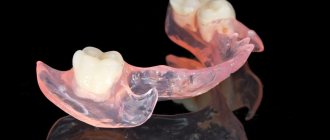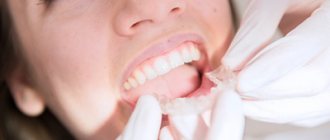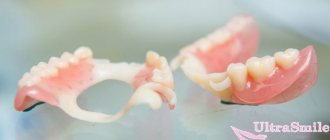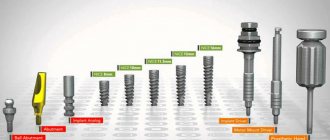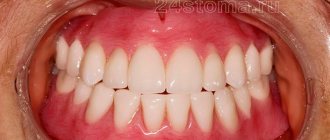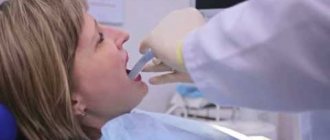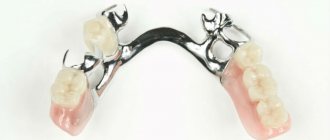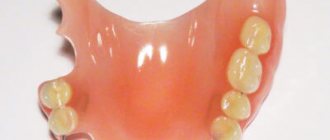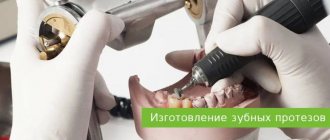Dentures made from the hypoallergenic material Acry Free are comfortable, moderately elastic, do not deform from chewing loads, and maintain aesthetics throughout their entire service life. They are used for complete or partial absence of teeth. If implantation is contraindicated, it is a quick and affordable option for restoring lost teeth. Our task is to make such a prosthesis so that no one will guess about the patient’s problem. We make them in our own dental laboratory, taking into account the individual parameters of each person - bite, facial features.
Features of Acry-Free prostheses
Acry-Free is a special polymer from which removable dentures are made; it does not contain toxic monomers, does not cause allergies, and does not have a specific plastic taste.
The material is not too hard and moderately elastic, “adapts” to the characteristics of the jaw relief. Dentures are lighter and thinner than conventional acrylic ones - they do not rub the gums. And they are denser than nylon ones - they do not deform from chewing loads. Comfortable to wear even with complete absence of teeth. And moderately elastic hooks in partial structures do not injure the supporting teeth.
The structures are translucent, the color of the artificial gum is matched to the natural one, so the dentures are practically invisible in the mouth. The manufacturing technology ensures the absence of pores, which guarantees hygiene - food dyes do not accumulate and no unpleasant odor is formed. The material lends itself well to polishing, which allows you to achieve perfect smoothness. In case of breakdown, it can be repaired.
Indications
Prosthetics with Acry-Free are indicated in several cases.
Namely, we are talking about those patients who:
- Are allergic to metal or plastic;
- Lost the dentition completely;
- They suffer from bruxism – teeth grinding at night;
- They do not have several or one tooth in a row;
- They suffer from epilepsy, diabetes, heart and vascular diseases;
- Have a job that is characterized by increased trauma;
- Suffer from periodontal disease or periodontitis. In this case, the prosthesis will prevent loosening and loss of teeth;
- They have sensitive and weak gums that cannot be supported by another type of denture.
There are many indications for using the product. That is why a large number of patients choose it. Due to the fact that the product is placed delicately in the oral cavity, it is recommended for use by elderly people and children.
Advantages
Acry-Free is the latest generation material; thanks to its improved characteristics, dentures made from it look natural, do not fall out, and do not rub the gums.
- Hypoallergenic The material does not contain toxic monomers that cause redness or burning of mucous tissues - it does not cause irritation or an allergic reaction in the body.
- Aesthetic Translucent, matched to the tone of the gums; clasps for partial dentures are made not of metal, but of the same material - it looks organic and natural-like.
- Comfortable Moderately flexible and elastic, compact, exactly matches the shape of the prosthetic bed - comfortable to use, does not rub the gums.
- Hygienic It has a monolithic structure and a smooth surface - plaque and bacteria do not stick to the prosthesis, there is no odor, cleaning is easy and quick.
Chashchin Kirill Valerievich
Orthopedic dentist, 14 years of experience
Digital prosthetics. Aesthetic restorations with veneers with a lifetime guarantee. Total orthopedic rehabilitation in one day
More about the doctor
Care
Caring for your prosthesis is easy. They must be rinsed after each meal, and once every 7 days the product must be immersed in a special solution for deep cleaning. It is not necessary to remove the denture every night.
How to clean the product with a brush? It should be soft, and the use of abrasives is contraindicated. The cleaning procedure can be carried out both in the morning and in the evening, as well as after meals.
There are special brushes for dentures, the shape of which makes it possible to clean more effectively. They have bristles on both sides of the head, and on one side of the head the bristles are zigzag. It perfectly cleans the outer surface of the product.
On the other side the bristles are slightly rounded. And its scope of application is cleaning the concave side of the base.
With proper care, removable dentures last a very long time (about 7 years) and do not cause inconvenience to the patient. Do not forget that to correct the product you will have to visit the dentist 2 times a year. How to store the structure? It is enough to put it in a clean and dry place.
Fixation for complete and partial absence of teeth
Dentures include a base and artificial crowns. The designs differ depending on the number of lost teeth and the location of the defect - on the upper or lower jaw.
- Complete denture is attached to the oral cavity due to the suction effect. On the upper jaw, it includes an artificial palate, which increases the area of contact with soft tissues and provides better fixation. On the lower jaw it rests only on the gums, is less stable, adhesive creams or gels may be required.
- Partial denture is equipped with clasps - hooks that clasp the supporting teeth to fix the structure. The retaining elements are also made of elastic plastic, do not damage the enamel, and no grinding of teeth is required. The color matches the shade of natural gum, the fastenings are invisible during a conversation and when smiling.
Our task is to make a prosthesis so that the patient is comfortable
We always strive to bring the work to the ideal in terms of comfort and aesthetics. So that the prosthesis does not lie “on a shelf in a glass”, but a person can use it.
Levin Dmitry Valerievich Chief physician and founder of the Doctor Levin center
A few words about service life
The service life depends on several factors - the strength and maintainability of the material, the ability to absorb or not absorb liquids, pigments, and foreign odors. It is also important how well a person takes care of orthopedic structures. In this regard, a more reliable option is Acrifri dentures with a service life of about 5 years. They are not very elastic, durable, subject to repair and relining, polish well, and are quite easy to clean and disinfect. Therefore they last longer than nylon ones. The latter, even with adequate care, will stretch very much in 2-3 years, and it will no longer be possible to use them normally. Nylon ones need to be cleaned longer and more thoroughly, as well as soaked in a disinfectant solution.
Computer diagnostics - for reliable data
It is performed on a GALILEOS tomograph (The Dental Company SIRONA, Germany).
- Assessment of the condition of bone tissue for the selection of material and height of the prosthesis base
- Study of the position and functions of the temporomandibular joint
- Determination of the condition of abutment teeth during partial dentures
Underwater rocks
Despite the obvious advantages of acrylic-free dentures, they are still imperfect and have some operational features:
- Long period of adaptation. Due to the physical properties of the material, the denture is quite soft, which requires long-term adaptation.
- Color change. Taking certain medications can change the color and transparency of the prosthesis base, making it visually more noticeable.
- Problem with clasps. Some patients note that the hooks that secure the prosthesis to their own teeth break off. This defect is easily eliminated, since acrylic-free dentures can be repaired in a regular dental clinic.
- Bone tissue atrophy. This disadvantage is inherent in all removable structures. Pathological changes in the bone occur due to uneven distribution of the load on the jaw when chewing food. To reduce atrophy, dentists recommend not removing dentures at night.
Use of facebow and articulator - for precise bite
Functional diagnostics using SAM3, Protar or Amann Girrbach systems.
- Determination of jaw relationship, bite diagnosis
- Manufacturing of an individual prosthesis according to the parameters of the dental system
- Preventing overload and dysfunction of the temporomandibular joint
Own digital laboratory - speed and quality
The Center has a digital dental laboratory with a staff of experienced qualified dental technicians.
- Reducing prosthetics time, quality control at every stage
- Highly accurate digital impressions without impression material errors
- Instant exchange of information between the orthopedic surgeon and the dental technician
Comments
[…] preference for new generation prostheses like Acree Free, they are more advanced, less allergic, but their […]
How to treat adentia? The most effective methods. (08/17/2018 at 09:00) Reply to comment
[…] Next, the doctor studies the type and shape of the future prosthesis, tries it on (also […]
CAD/CAM technology for making ideal dentures (09/04/2018 at 09:00) Reply to comment
Write your comment Cancel reply
Stages of prosthetics
To produce a prosthesis that matches the patient’s personal parameters, several visits to our Center will be required.
- Diagnostics On the first visit, the doctor performs an examination and conducts CT diagnostics to assess bone and mucous tissues, and the condition of the remaining teeth. In case of pathologies, gums and root canals are treated.
- Taking impressions Digital and/or traditional impressions are taken with impression material, and a photographic protocol is carried out. The data is transferred to the dental technician to make a model on which the prosthesis will be created.
- Determination of occlusion Using a facebow and an articulator, the closure of the jaws in central occlusion is fixed. The data is used to help the technician place the teeth in the correct position on a wax model of the future prosthesis.
- Fittings The wax structure is fixed in the mouth and the fit is checked. The patient evaluates the sensations and degree of comfort, the doctor evaluates how harmoniously it fits the parameters of the face. If necessary, a series of corrections are made.
- Production The prosthesis is made in the laboratory - the wax is melted down and replaced with an artificial base from Acre-Free. At the same time, the shape of the base and the location of the teeth remain unchanged. Finally, the denture is ground and polished for perfect smoothness.
- Installation The finished prosthesis is tried on in the oral cavity, the fit is checked, how it sits when closing and opening the mouth, and moving the jaws. The bite is fixed again, the prosthesis is transferred to the articulator, the doctor checks and eliminates inaccuracies.
Then the important moment of adaptation occurs. A person gets used to the denture and learns to chew with new teeth. The doctor schedules follow-up visits to check how the addiction is progressing and whether there are any chafing or irritation of the mucous tissues. If necessary, makes the required number of adjustments.
How to restore diction
To restore diction, it is recommended to speak as much as possible: read books, pronounce tongue twisters, while holding one or more sweets in your mouth (without sugar! For example, Sula with mint or sea buckthorn).
15-20 minutes, several times a day. The duration of the course is the first 1.5-2 weeks after prosthetics. Tongue twisters for restoring diction after removable prosthetics
| For your convenience, we have selected several useful tongue twisters |
| The snout pig was white-nosed, blunt-nosed; I dug up half the yard with my snout, dug, dug. |
| Karl stole Klara's advertising, and Klara stole Karl's budget. |
| In Kabardino-Balkaria, valocordin from Bulgaria. |
| The fast talker quickly said quickly, That you can’t quickly talk all the tongue twisters, but you can’t over-speak all the tongue twisters, But, having quickly spoken, he quickly said, That you can’t talk all the tongue twisters, but you can’t over-speak. |
